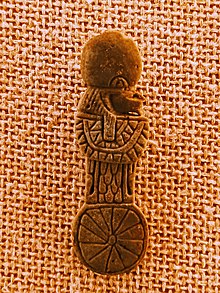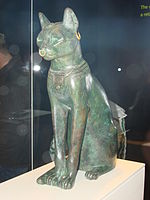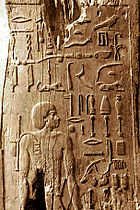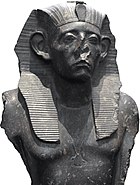
Suspension hole on 3-god plaque, lug-holes on: papyrus stem, Menats-(counterpoise)(?), large heart(?)(bottom-right)
(Photo: High-Res expandible).
Row 3: (4)-Heart amulets.



An amulet, also known as a good luck charm, is an object believed to confer protection upon its possessor. The "Amulets of Ancient Egypt" fall in approximately seven major categories:
- Amulets of gods/goddesses and sacred animals
- Amulets of protection (or aversion)
- The scarab for the living, (or for a funerary offering)
- Amulets of assimilation
- Amulets for powers
- Amulets of possessions, property, or as offerings
- (symbolism of materials)
The first usages are from time periods of: ED, Early Dynastic Period, FIP, First Intermediate Period, G-R, Graeco-Roman Period, LD, Late Dynastic Period, MK, Middle Kingdom, NK, New Kingdom, OK, Old Kingdom, SIP, Second Intermediate Period, and TIP, Third Intermediate Period.
| Amulet | Egy. lang. equiv | Discovered by | Usage-or- Origin |
City/ cemetery |
Notes | |
|---|---|---|---|---|---|---|

|
Papyrus stem (hieroglyph) (scarab at left) |
udjt utchat |
5th Dynasty | Mastaba | One of the 14 Spirits of Ra-(no 5); meanings of youth, viguor | |

|
Girdle of Isis/Knot of Isis Tyet (and Djed Pillar) |
tyt | Flinders Petrie | 5th Dynasty | Mastaba |
Amulets of protection
Amulets of protection: animals, gods, goddesses, etc.
Ankh Amulet
|
(seated)-block statue of: Cuboid Statue of Tety called Tetyty, (photo), British Museum
| Amulet | Egyptian. lang. equiv | Discovered by | Usage-or- Origin |
City/ cemetery |
Notes | |
|---|---|---|---|---|---|---|

|
Ankh-Amulet on necklace |
'n(kh) | British Museum, acquired by E. A. Wallis Budge | 1475BC | Karnak-(?) | protection, or honorary amulet part of hieroglyph-statement-theme: an(kh)-hot(e)p (+ on right and left hands: symbols of Upper and Lower Egypt + Sun + Moon); modern meaning: Enjoy: Life & Peace, everywhere the Sun and Moon is present, (all of Egypt) see wikicommons: Block statues of Egypt |
Bes Amulet
|
(shiny boxwood statuette) Young Girl, (shaved head with youth side lock), Carrying oversized Pot The Durham Servant Girl, (photo, Durham Museum)
| Amulet | Egy. lang. equiv | Discovered by | Usage-or- Origin |
City/ cemetery |
Notes | |
|---|---|---|---|---|---|---|

|
medium-sized Bes Amulet on necklace |
Durham University Museum acquired after 1816, by Lord Algernon Percy |
(reign of Amenhotep III) | from pit, near TT52 owned by First Prophet of Amun, MeryPtah |
protection, or honorary amulet (no photo, at present) for God of Children, or Youth boxwood, small cosmetic container-(in non-standard/expressionist style) |
-
 Motif:
Motif:
(non-formal Egyptian style): Dwarf /(Child) Carrying Oversized Container
Amarna Period, reign of Akhenaten, 1353-1336 BC
Eye of Horus Amulet
|
Gayer-Anderson cat, (donated to British Museum)
| Amulet | Egy. lang. equiv | Discovered by | Usage-or- Origin |
City/ cemetery |
Notes | |
|---|---|---|---|---|---|---|

|
Plaque-Necklace as Eye-of-Horus Amulet |
(Late Period of Egypt) | cat, as cat-Goddess Bastet British Museum |
Eye of Horus Amulet, Thoth-Baboon statues
|
| Amulet | Egy. lang. equiv | Discovered by | Usage-or- Origin |
City/ cemetery |
Notes | |
|---|---|---|---|---|---|---|

|
Plaque-Necklace as Eye-of-Horus Amulet |
baboon, as god-Thoth Louvre (no. E17496) |
Other types of plaque-necklaces on Thoth-baboon:
3-Fox-Skins
|
vertical Painted Relief Panel of Iry, Scribe, ((correct vertical)-Painted Panel Relief of Iry. )
| Amulet | Egy. lang. equiv | Discovered by | Usage-or- Origin |
City/ cemetery |
Notes | |
|---|---|---|---|---|---|---|

|
3-fox skins on necklace |
ms, "born of" examples: Pharaoh Ahmose: "Moon-Born", or: Kamose, "Spirit-Born" |
4th Dynasty (2613–2589 BC) |
Iry's Tomb, Saqqara | protection(?), or honorary amulet(?) --- (Actual Photo of Iry's Panel, see British Museum page) (photo shown of similar vertical panel, same period of hieroglyphs: wood panel of Hesy-Ra) |
Fringed-Fabric ligatured w/ vertical S-(folded cloth)
|
| Amulet | Egy. lang. equiv | Discovered by | Usage-or- Origin |
City/ cemetery |
Notes | |
|---|---|---|---|---|---|---|

|
Fringed-Fabric with S folded cloth-Symbol on necklace |
Narmer Palette, Predynastic Egypt or Old Kingdom |
the palette is from Hierakonopolis | behind Pharaoh Narmer, attendant carrying "pair of sandals": his title from necklace: Steward of the Pharaoh's Wardrobe necklace of authority (see expanded version: Attendant of Pharaoh Narmer) |
Heart amulet
|
| Amulet | Egy. lang. equiv | Discovered by | Usage-or- Origin |
City/ cemetery |
Notes | |
|---|---|---|---|---|---|---|

|
Heart Amulet on necklace |
TT55, tomb of Ramose (TT55), (in Theban Tomb 55) | Necklace with Heart-shaped amulet Central Figure, under 2-opposite-facing Water Libation vessels streaming Water-streams. Usekh collar, double-stranded necklace w/ large amulet laying upon the collar. Wikicommons, Tomb of Ramose |
Pectoral Necklace
|
| Amulet | Egy. lang. equiv | Discovered by | Usage-or- Origin |
City/ cemetery |
Notes | |
|---|---|---|---|---|---|---|

|
Pectoral on necklace |
Louvre Museum | suspension loop -- (for necklace) |
Unidentified amulet
|
(two statues) Prince Rahotep, and wife Nofret
| Amulet | Egy. lang. equiv | Discovered by | Usage-or- Origin |
City/ cemetery |
Notes | |
|---|---|---|---|---|---|---|

|
possibly: 3-fox skins on necklace (for husband: Prince Rahotep-wife Nofret has a Usekh collar-type necklace) |
4th Dynasty (2613–2589 BC) |
the couple's Mastaba at Meidum | protection(?), or honorary amulet(?) |
Amulet necklace statues of Senusret III
|
– (created by Senusret III(?), or from Kush country(?))
Statues of Senusret III
| Amulet | Egy. lang. equiv | Discovered by | Usage-or- Origin |
City/ cemetery |
Notes | |
|---|---|---|---|---|---|---|

|
pierced object amulet on necklace |
12th Dynasty (ca 1850 BC) (post Kush campaigns(?)) |
Senusret III statue at British Museum | protection(?), or honorary amulet(?) found on multiple statues |
Scarab amulets
For Scarab as an artifact, jewellery part, writing surface, grave good, see Scarab (artifact).Amulets of assimilation
2-Wine-Jars
|
(tomb relief) Maya (Egyptian) w/Staff and hieroglyph inscriptions–(Tomb of Maya)
| Amulet | Egy. lang. equiv | Discovered by | Usage-or- Origin |
City/ cemetery |
Notes | |
|---|---|---|---|---|---|---|

|
2-Wine-Jars amulet on necklace |
irp, 'wine' (Det.) |
Geoffrey Martin 1986- (Re-working of Saqqara tombs-newly discovered tomb) |
Tomb of Maya Maya was Treasurer of Tutankhamun |
Abundance (no photo link, at present) (see Pectoral (Ancient Egypt)) |
References
- Keller, 2000. Bowers Museum of Cultural Art, 2000. Egyptian Treasure from the British Museum, Statue of Tety, p. 44-45.
- Keller, 2000; Statue of Tety, p. 45.
- Reeves, 2000, Ancient Egypt, The Great Discoveries, a Year-by-Year Chronicle, 1816-1818, p. 19.
- Keller, 2000. Bowers Museum of Cultural Art, 2000. Egyptian Treasure from the British Museum, Relief Panel of Iry, p. 40-41.
- Reeves, 2000, Ancient Egypt, The Great Discoveries, a Year-by-Year Chronicle, 1975: New Kingdom Tombs at Saqqara, pp. 215-219, Other tombs - and Maya, pp. 218-219.
- Andrews, Carol, 1994. Amulets of Ancient Egypt, chapter 4: Scarabs for the living and funerary scarabs, pp 50–59, Andrews, Carol, c 1993, University of Texas Press, 518 amulets, 1, or multiples included in 12 necklaces; (softcover, ISBN 0-292-70464-X)
- Keller, 2000. Bowers Museum of Cultural Art, c 2000. Egyptian Treasure from the British Museum, Peter Keller, (Bowers), Robert Anderson, (British Museum), Carol A.R. Andrews, (British Museum), Relief Panel of Iry, p. 40-41. (softcover, ISBN 0-9679612-0-3)
- Reeves, 2000. Ancient Egypt, The Great Discoveries, a Year-by-Year Chronicle, Nicholas Reeves, (Thames and Hudson Ltd, London), c 2000. 1975: New Kingdom Tombs at Saqqara, pp. 215–219, Other tombs - and Maya, pp. 218–219. (1816-18): After 1816, The Durham Servant Girl, p. 19. (hardcover, ISBN 0-500-05105-4)
External links
- Attendant of Pharaoh Narmer, Wikicommons
- The Durham Servant Girl-(photo), a boxwood kohl pot-(for kohl), Ancient Egyptian cosmetic containers; Article
- (vertical)-Painted Panel Relief of Iry.
- Tomb of Ramose




